The East Asian style kitchen originated in China, was transmitted to Korea and then on to Japan.In each country, the kitchens took on their own unique structures and features according to thelocal climate and customs. Though the modern kitchen may be no more than a place for cookingand eating, the traditional kitchen was a place of faith, a place where women would pray for thewell-being and prosperity of the family.
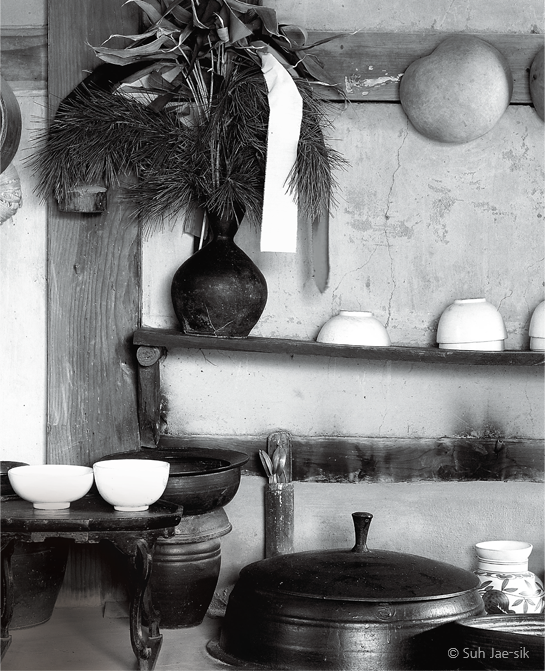
A bowl of fresh clear water embodies the kitchen god called Jowang, the powerful deity in a traditional Korean house. The worship of the kitchen god, or the stove god, is derived from an age-old tradition of fire worship in Korean folk beliefs. Sometimes, a pine twig accompanies the bowl.
The oldest extant record to mention the Korean kitchen is found in the Chinese classic “Record of the Three Kingdoms” (San guo zhi) written by Chen Shou: “As the place serving the Kitchen God they have a reverent air, and are all located to the west of the gate.” It is just one line, but a valuable record that reveals the location and distinguishing feature of Korean kitchens. “West of the gate” applies to houses with a southern orientation, and in the past this was where the kitchen was located in almost all Korean homes. Scientifically, it was a well-thought-out location, for if the kitchen were located to the east of the gate, the strong Siberian winds would cause trouble with the smoke from the furnace.
No similar concept lies behind the arrangement of Chinese and Japanese kitchens, the main reason being that no flues for directing heat to the rest of the house are attached to their kitchen furnaces. Hence, the book mentioned above makes special reference to the west side location of Korean kitchens.
Another important ancient source that provides an insight into the Korean kitchen within a particular era is found among the murals of Anak Tomb No. 3, which is dated to the 4th century and located in Anak County, South Hwanghae Province, in what is now North Korea. The occupant of the tomb is believed by some to be King Gogugwon of the Goguryeo Kingdom. Another theory argues that the occupant is Murong Huang, ruler of the short-lived Former Yan in the era of the Sixteen Kingdoms of China; yet another proposes that the tomb belongs to Dong Shou, a general of Former Yan who settled in Goguryeo in 336 and died in 357.
Kitchens in Ancient Tomb Murals
Depicted in the tomb murals is a remarkably intimate glimpse of domesticity: a busy, well-stocked kitchen, a free-standing building with tiled roof and gables. In the old days, in the royal palaces or the homes of the wealthy, the kitchen was a separate structure called banbitgan, located behind the inner quarters occupied by the women of the household. An entry from the sixth month of 1666 in the “Annals of the Joseon Dynasty” (Joseon wangjo sillok) calls the kitchen maids banbi. But the two kitchens at Gyeongbok Palace, which were restored in 2015, are both named sojubang. This name appears in an entry for the 11th month of 1632 in the “Diaries of the Royal Secretariat” (Seungjeongwon ilgi), so it appears that in the 17th century at least, both banbitgan and sojubang were terms used to describe the kitchen. One royal kitchen carrying the name banbitgan, dating to the reign of King Sunjo in the early 19th century, remains intact at Changdeok Palace.
In Korea, the body of the kitchen god usually takesthe form of water. Water is not only an auspicious god thatwashes away misfortune and brings good luck,but also the god responsible for birth and new life, anda guardian deity who protects against fire.
The main ive in separating the kitchen from the other buildings was to prevent fire from spreading and to keep cooking smells at a distance. Another reason was that large amounts of food had to be prepared at the same time. For the same reasons, in some homes a kitchen annex called handet bueok, meaning the “outdoor kitchen,” was built near the main kitchen.
Such free-standing kitchens were introduced from China. Among the 22 pictorial stone relief carvings discovered on tombs from the Han Dynasty, 10 are from the Shandong area, which bends across the Yellow Sea toward Korea. It is natural that the Goguryeo tomb murals, which were influenced by China, closely resemble those pictorial reliefs. In the Anak tomb painting, the crows depicted on the roof ridges are also a sign of Chinese influence. In ancient China, the crow was a symbol of the Sun God, and an emblem of dynastic kings, a tradition that was adopted by the Baekje people.
The mill, stable, well, and meat storage with butchered animals hanging on meat hooks featured in the Anak Tomb No. 3 murals all reflect the Chinese style as well. Judging from the murals, the possibility of Dong Shou being the owner of the tomb cannot be ruled out.
Koreans today use the words bueok and jeongji to describe the kitchen. Both words have the same meaning, and their usage differs according to regional parlances. The word bueok is mainly used in the western part of the peninsula, including the Pyongan and Hwanghae provinces in the north, as well as Gyeonggi Province, parts of the Chungcheong and Jeolla provinces, and Jeju Island. The word jeongji is predominantly used on the eastern side of the peninsula, in the Hamgyong and Gangwon provinces as well as parts of the Chungcheong, Gyeongsang and Jeolla provinces. Such regional divide suggests they were actually once describing two different types of kitchens.
Linguistic Divide
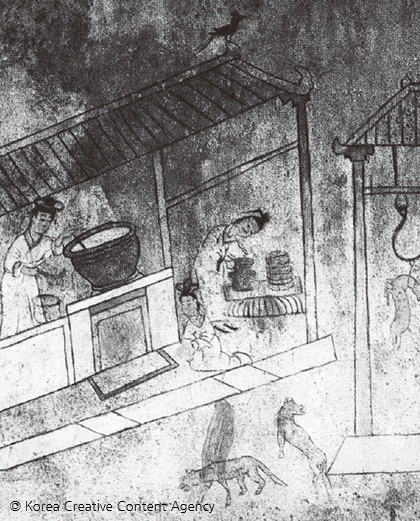
A mural in Anak Tomb No. 3, which is dated to the 4th century Goguryeo Kingdom, contains many valuable clues to ancient Korean kitchens. The tomb is located in Anak County, South Hwanghae Province, in what is now North Korea.
The earliest extant record to contain the word bueok is the Korean translation of Du Fu’s poems published in 1481. The first syllable bu comes from bul, which means “fire,” whereas the second syllable eok is a suffix indicating place. At the time, the pronunciation was closer to buseok, which is, interestingly, similar to the Jeju dialect word buseop, meaning “furnace.”
The word jeongji originates from a type of house named gyeopjip found in Hamgyong Province, where the rooms are arranged in two parallel rows to keep out the cold, placing the kitchen in the middle. The Oroqen people who lived in the northwestern mountains of China’s Heilongjiang Province, close to Korea’s Hamgyong Province, traditionally lived in tents. A fireplace was situated across from the entrance, behind that a section called malo, or malu, and to the right were the jeongjidwi, the women’s quarters. The Korean word maru, referring to the wood-floored hall in a traditional house, is said to come from the Oroqen word malo, thus it can be conjectured that today’s Korean word jeongji, for kitchen, is of similar origin. That Heilongjiang Province used to be part of Goguryeo’s territory in ancient times makes this a fair assumption.
The Chinese word for kitchen is chu. Originally, the word referred to the dish in which brine-pickled vegetables were served but it then changed to mean the place where food is prepared and cooked. Cooks are called churen or paoren, both literally meaning “kitchen person.”
In Japan, the kitchen is called daidokoro or katte. The etymology of daidokoro is traced back to daibandokoro, a compound of daiban (a portable tray table) and tokoro (place) — referring to the room where portable trays of cooked food were prepared to be served at imperial palaces and households of the nobility during the Heian period.
In later periods, daidokoro referred to the kitchen area in samurai homes and bigger farmhouses where large iron kettles were kept over a fire. It also meant a footed vessel used to store food at the royal palace and the homes of the aristocracy. Katte originally meant the right hand, which was used to pull the bow in archery. The meaning is said to have later changed to “livelihood,” based on the argument that the right hand is easier to use than the left, and it then changed again to mean “kitchen.”
Where Gods Dwell in Every Home
According to the “Record of the Three Kingdoms,” the earth gods were worshipped in different ways but they all resided on top of the kitchen hearth, west of the gate. The classification of earth gods reflects the same geographic-linguistic divide that has Koreans today use two different names for their kitchens: the kitchen god was worshipped in Seoul and the Chungcheong and Gyeongsang provinces, while the fire god was worshipped in Jeju and the Chungcheong and Jeolla provinces. The kitchen god is called Jowang, who is female, acknowledging that the person in charge of the kitchen was generally a woman. The fire god is called Hwadeok. This name is probably more familiar to the Korean people, as Jowang remains conceptual while Hwadeok refers directly to the fire that is used every day.
The body of the deity is physically represented by a bowl of water placed on the ledge at the back of the kitchen hearth (buttumak) or behind the iron pot (sot) that was a permanent fixture in traditional Korean kitchens. Every morning, the lady of the house would pour a little bit of the water from the bowl on the stovetop, into the furnace, on the pot lid, and in the water jar, then fill the bowl again with water freshly drawn from the well and pray for the well-being and happiness of the family that day.
In contrast, in the kitchens of Jeju Island where the furnace had no such stovetop, the stones that held the pots in place over the fire were worshipped as the kitchen gods. The typical Jeju kitchen furnace had three such stones, so there were three kitchen gods. Collectively, they were called Samdeok and offerings were made to each one of them. When moving to a new home, the family always took the kitchen gods from the old house to the new house to ensure that the good fortune enjoyed in the previous home would continue. Similar customs were practiced among the tribes of Sichuan, Yunnan and Guizhou provinces in China.
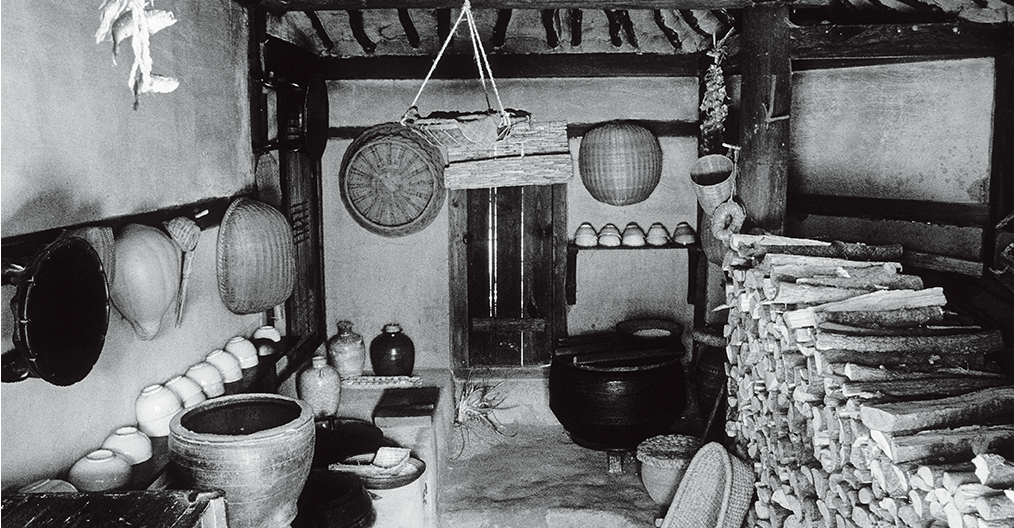
The typical Korean kitchen was located to the west of the front gate of south-facing houses to avoid the westerly winds from Siberia. The furnace was installed at the bottom of the wall joining the kitchen to the rooms to enable cooking and heating at the same time. Firewood was stacked up on the side opposite the furnace.
In Korea, the body of the kitchen god usually takes the form of water. Water is not only an auspicious god that washes away misfortune and brings good luck, but also the god responsible for birth and new life, and a guardian deity who protects against fire.
In contrast, in China the kitchen god is usually represented as a painting. Pictures of the deity painted on paper are either bought at the market or made at home, and sometimes a spirit tablet made of paper and mounted on wood is also used for the same purpose. In large Korean temples, a picture of the kitchen god is hung in the kitchen and the “Heart Sutra” is recited after the rice is cooked, both of which can be traced to Chinese influence. In the Chinese tradition, the kitchen god is a servant sent by the Jade Emperor in heaven to watch over the affairs of the human world, and as in Korea, she is female. In the northeastern part of Japan, the kitchen god, or god of the hearth, is manifested in a fierce looking wooden mask.
Generally, the kitchen god comes down to the human world on the last day of the year, takes a look around all the houses, and then reports back to heaven. The emperor of heaven dispenses good fortune to the households that have accumulated virtue and punishment to those that have committed evil. Around the end of the year, taffy or the lees left over from brewing alcohol was stuck on the kitchen furnace to keep it quiet, as the furnace was believed to symbolize the mouth. People also tried to curry favor with the kitchen god by offering rice cakes or fruit and even a horse on which it could ride away.
Chimney and Cooking Range:From Korea to Japan
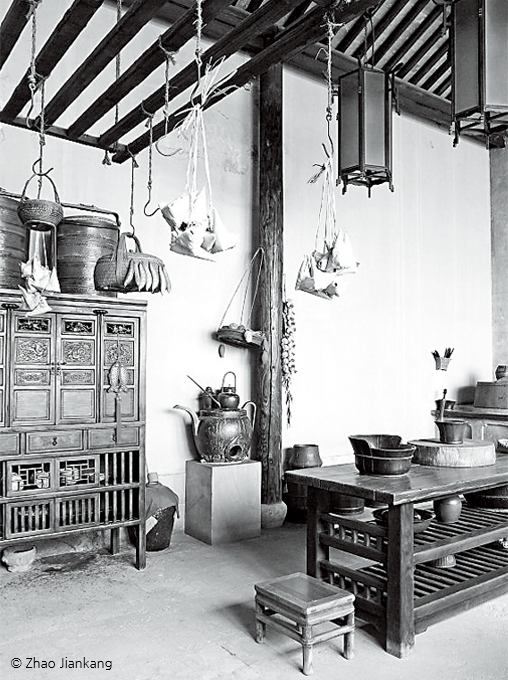
In Chinese houses, with some regional differences, the rooms were generally heated with braziers so there was no need for the kitchen furnace to be built close to the other rooms. Often the kitchen was a structure separate from the rest of the house. This type of kitchen was introduced to Korea, where it was called banbitgan.
In his book “History of Kitchen Utensils,” the Japanese industrial designer Kenji Ekuan (1929–2015) noted, “It is astonishing to think that the kamado [cooking range] did not exist in Japan until it was introduced from Korea … Thanks to [the kamado] not only has fuel efficiency improved, the chimney has freed people from smoke.” It is also called kan kamado or kara kamado, both of which mean “Korean kamado.” The Korean cooking range is still revered at some Japanese shrines and museums today.
After the introduction of the cooking range to Japan, the iron pot naturally followed. Hakuseki Arai (1657–1725), a scholar-bureaucrat from the Edo Period, said, “In the old days, kama was the word for the cooking range, and later it was used for the kitchen pot also. This comes from Korean dialect. In Joseon, it is still used to refer to the iron pot.”
“Kama” is the North Korean word for the cooking range, known elsewhere as buttumak. “Iwanami’s Dictionary of Ancient Japanese,” published in 1990, explains that the Japanese word “is rooted in the Korean word kama [gama].” Its entry into Japan is linked to the introduction of Hamgyong Province-style houses to the northeastern part of Japan.
The wonder that the Japanese felt upon seeing the Korean iron pot for the first time can be surmised from the fact that the kitchen god in the form of an iron pot is still revered at Karakama Shrine in Izumo, Shimane Prefecture.
The kitchen range not only brought the iron pot to Japan but also the chimney. A paper from 1906 titled “Comparative Study of Korean and Japanese” by Kaoru Nakata (1877–1967) says, “Today the kitchen range is called kudo, the result of a change in meaning, for in the past kudo meant ‘chimney.’ The similar Korean word is gulttuk ... This relationship was formed in ancient times.”
Kudo Shrine in Nara, Japan, takes a Baekje person as its principal deity and the iron pot as the earth god. The inscription on the side of the pot reads “dedicated in the eighth month of the foundation year of the Keian era [1648],” which indicates that the pot was newly made at this time. The surrounding area was once inhabited by many Baekje people.
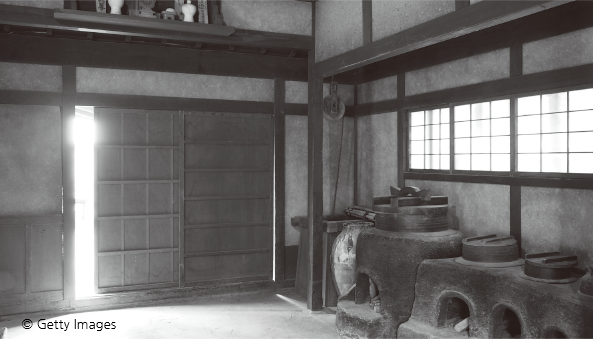
In Japanese kitchens, cooking took place over a brazier before the kitchen range, kamado, or buttumak in Korean, was introduced from Korea. The cooking range was considered an amazing thing and is still revered as the kitchen god in the form of an iron pot in some Japanese shrines today.
In an article contributed to a daily newspaper in 2007, Hong Yun-gi, professor of Korean studies at the University of Brain Education, quoted the historian Konan Naito (1866–1934): “The Kudo deity is King Gutae [Daeso], ancestor of King Seongmyeong [King Seong] of Baekje.”
If one were to compare the kitchen culture of East Asia to a tree, China constituted the roots, Korea the trunk, and Japan the branches. As examined above in their historical contexts, the kitchens of the three countries took on different features and functions as they evolved to reflect the times, needs and circumstances of those who worked in them, which resulted in innovations and diversity. Just as flowers bloom on a tree’s branches, it can be said that East Asian kitchen culture has blossomed in Japan.
Kim Kwang-onProfessor Emeritus, Inha University